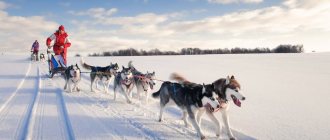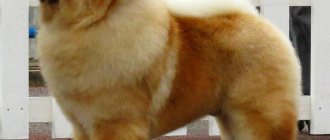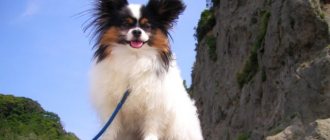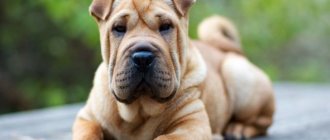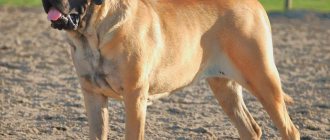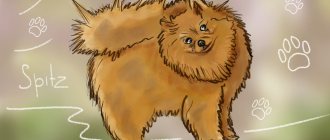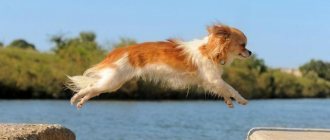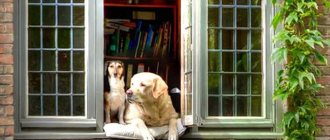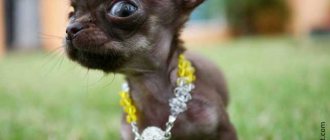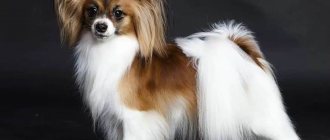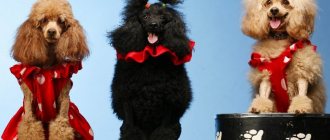We love to feel protected. This is natural for humans. This is basically why people get big angry dogs. This is how they try to keep uninvited guests away. However, there are not only positive aspects to owning such animals. There are also many disadvantages. The strongest dogs in the world, the breeds of which we will discuss below, are, for example, not the best option for families with children. Most of them also require special conditions. We tried to present the pros and cons of owning these beautiful and at the same time dangerous animals.
American Bandog
This breed was created by crossing a mastiff with a bulldog.
- Pros: Bandogs are used as guard dogs, and they do an excellent job. Brave and strong, these dogs will give their lives for their owners. These massive animals have short, easy-to-groom fur. Bandogs can be affectionate and loyal to their owners, but they are not recommended to be allowed near children and other animals.
- Cons: Because they are primarily guard dogs, they can be very dangerous. Need intense training. They are wary and distrustful of strangers, so from birth dogs must be taught not to rush at the first person they meet. For many, the Bandog is considered a mongrel. If you are not completely sure that it is the Bandog that you need, then it is best to choose another breed.
Bernese Mountain Dog
This woolly dog prefers cool climates. The breed is also called the Bernese Shepherd or Greater Swiss Dog.
- Pros: While Bernese Mountain Dogs are considered one of the strongest breeds, they are also great with children and other pets. These are affectionate and friendly dogs. Mountain Dogs love to work and enjoy learning tricks and playing sports. Thanks to their natural intelligence, these giants are easy to train. It is very important for them to please their owners. There is no aggression in these fur giants and they are friendly to everyone they meet.
- Cons: they are very beautiful, but beauty requires constant care, and the long coat makes this task tiring. The Bernese Shepherd also sheds quite a lot. If you don't like being licked, this slobbery beast is not for you. Due to its excessive playfulness, the breed needs obedience training from a very early age.
German boxer
This breed has an imposing stature that belies its personality. Usually it won’t hurt a fly, but if the dog is not trained, it can attack smaller animals.
- Pros: They are affectionate dogs that are very good with family, including children and other dogs. Boxers are intelligent and easy to train. They do not bark so often and do not try to escape from their owners. This energetic family member will be able to adapt to apartment life if given exercise.
- Cons: Due to their muscular body, boxers have an intimidating appearance, but this is a false impression. In fact, due to their excessive friendliness, they are not even used as guard dogs. Boxers love mild climates, so care must be taken when going outside in cold or hot weather. Although this is one of the strongest breeds, these dogs do not tolerate loneliness well and do not like to be left alone for a long time.
Boerboel
An African breed of dog, which is not yet recognized by the FCI, and due to its aggressive nature is prohibited in some countries of the world. A very strong and resilient dog that grows up to 80 cm at the withers, and is also flexible and has a lightning-fast reaction.
A powerful dog with well-developed muscles can develop great speed. It needs to be dealt with, otherwise a lack of physical activity can cause aggression.
In the world, including in Russia, cases of attacks on people have been recorded, which is why the Boerboel is included in the list of dangerous dogs.
7
Bulldog (pit bull, American, English, etc.)
Bulldogs have a bad reputation because of their similar appearance to pit bulls. In fact, dogs of any breed can be obedient if trained correctly.
- Pros: Smart and loyal, these muscular companions are easy to train. Due to their short coat, bulldogs do not require long-term grooming. Known as “nanny dogs,” they love children. They are playful and caring. Most dogs of these breeds are calm and quiet.
- Cons: Make sure you get your pet from a reputable breeder who does not breed fighting dogs. Like other strong breeds of dogs, bulldogs need to be trained.
~Pitbull~
Next, the top of the strongest dogs continues with the interesting breed Pitbull. These animals are friendly and prefer to always be in the company of humans.
Nature has endowed the breed of strong dogs with an unusual skeletal structure and amazing muscles. It is these two factors that allow trained pit bulls to bear different weights. Initially, the animals were used to bait large and dangerous animals, then they were used by butchers to protect trade stalls with meat - while the stall was protected not from people, but from the invasion of other dogs.
Caucasian Shepherd Dog
This dog is capable of killing wolves and bears to protect its charges. This is the main reason why it is included in the list of the strongest dog breeds in the world.
- Pros: This breed was designed to survive in barren, wet lands and bitter cold. This is a tough nut to crack. Independent and confident, these dogs usually cope well with being alone. Brave and loyal, this breed commonly helps police and rescue workers in the former Soviet Union.
- Cons: if you have children, it is better not to get Caucasian Shepherds. Due to their thick fur, dogs do not tolerate warm climates well. If you want to use this dog as a guard dog or just as a pet, it will need to undergo serious training. Also, the Caucasian Shepherd should be taught loyalty to strangers.
The strongest and most powerful dog breeds in the world
It is quite difficult to give an objective assessment. Most often, primacy is given to fighting breeds, citing their champion past. Despite this, we should not forget about four-legged guards, sledding and hunting breeds. These animals are no less strong and resilient, since the efficiency of their work depends on these qualities.
Many people associate power with large size and aggression. But in fact, even small pets can have developed muscles, and giant dogs can be quite friendly. For this reason, do not rush to be surprised by the descriptions and photos of the largest and strongest dog breeds in the world, presented below.
Alabai, or Central Asian Shepherd Dog
The huge alabai evokes deep respect and even fear. Developed muscles and innate protective instincts make him a fearless and invincible defender.
Due to the potential danger to others, the Central Asian Shepherd must be trained. During training, it is important to be systematic and patient. Rare classes and excessive severity are unacceptable. Interest is no less important. Representatives of this breed will not follow commands without finding meaning in them.
Alabais are calm and independent. They quickly socialize and do not show aggression towards other four-legged animals. An attack on their part is possible only with outright provocation. In other situations, Central Asian Shepherds show a rather restrained distrust even of strangers.
Alaskan Malamute
The large and energetic Alaskan Malamute is often confused with the Siberian Husky. Despite this, their performance differs greatly. Huskies are sled dogs, and Malamutes are draft dogs. In their homeland, these four-legged animals are used to transport heavy loads. Behind the pretty and impressive appearance lies wide bones and massive muscular limbs.
The independent nature and dominant nature of Malamutes greatly interfere with their training. Not every owner will be able to hold the “reins of power” in a house with such a pet. Despite their innate good nature, Malamutes often show aggression towards other dogs, cats, birds and rodents. For this reason, they require mandatory socialization.
The main feature of representatives of this breed is inexhaustible energy. They turn the whole house upside down even after a long walk in the fresh air. Living in a private house does not help either. There they spend their energy digging giant pits and quite often arrange escapes.
Caucasian Shepherd Dog, or Caucasian Wolfhound
The Caucasian Shepherd is a strong guard dog, loyal to only one owner. The muscular wolfhound is not without charisma and charm, but behind the soft coat hides a rather stern character. Long-haired individuals are especially popular, while short-haired ones are often confused with Alabai.
The Caucasian Shepherd is on the list of the most dangerous breeds, but do not think that this makes it a bloodthirsty killer from birth. The behavior of an animal directly depends on its upbringing, so special attention should be paid to training and socialization. Only an experienced dog breeder can cope with a wolfhound, since a person who is too soft will be crushed by regular attempts at dominance.
The meaning of life for these harsh brutals is to protect people and their property. They are not susceptible to intimidation or flattery. Wolfhounds show love and friendliness only towards their owners. They remain neutral with other pets - but only if the animals are of more modest size. Shepherds perceive larger individuals as rivals.
Cane Corso
The stern and rather large Cane Corso is a descendant of former gladiator dogs. In Ancient Rome, this four-legged animal was used in military campaigns. From his ancestors he inherited sculpted muscles and impressive strength. Despite this, his gait is distinguished by the gracefulness of a panther.
The Cane Corso is easy to train. They are not prone to dominance, and a developed protective instinct is inherent in them from birth.
The Cane Corso has the genes of herding dogs, so you shouldn't be surprised at their love of order. Instead of sheep, representatives of this breed prefer to “herd” the children of their owners, carefully monitoring their safety. Similar actions apply to pets living with a Cane Corso in the same home.
Newfoundland
A powerful, big man with a bearish appearance has a luxurious fur coat. This four-legged athlete has excellent control over his body, so all his movements look elegant and graceful. The main feature of this breed is its webbed toes, which facilitate gliding when swimming, and a thick tail, used as a rudder when in the water.
Training a Newfoundland is a pleasure. This smart dog has an excellent memory and grasps new information on the fly. Only too harsh treatment can slow down learning. For this reason, the key to success lies in polite and gentle requests, spoken in the calmest voice possible.
Tactful and friendly giants are completely devoid of aggression towards humans. Instead, they are completely devoted to him and are always ready to help. These intelligent dogs work as guide dogs and save lives by participating in search and rescue operations.
Rottweiler
The brutal and muscular Rottweiler is a true athlete of the canine world. His smooth skin and short coat perfectly highlight all the advantages of his tightly built and pumped up body.
Information about the danger of the Rottweiler is explained by the lack of training. The dog reaches full psychological maturity only by 2 years. Until this moment, he can be very stubborn and self-willed, so patience and experience are required from the owner. To avoid problems in the future, it is better to entrust such a pet to a dog handler.
The Rottweiler's good nature does not extend outside the home. The dog views strangers as a potential threat, making no exception even for children. This innate suspicion is used to protect important objects.
Saint Bernard
Among the strong dogs, the Saint Bernard must be highlighted. This white-and-red giant is a typical companion, but after completing special training courses, you can make him an excellent watchman or rescuer. The gigantic appearance and severity of representatives of this breed are just a mask. In fact, they are so good-natured that they easily get along with any pet, including cats and birds.
Despite their developed intelligence, training St. Bernards is quite problematic. Their phlegmatic temperament often interferes with training. It’s better to forget about grasping on the fly.
Saint Bernards are wonderful nannies and devoted pets. They are difficult to piss off, so children can do whatever they want with them.
Siberian Husky
The main feature of the Siberian Husky is its spectacular appearance. Slightly slanted, almond-shaped eyes amaze with their depth. Blue color and heterochromia are most valued among dog lovers.
Huskies need to be raised in strictness and fairness. Excessive softness can spoil, and harshness can embitter. To get the desired results, it is important to interest your pet in the training itself. It is best to train a Husky in sports disciplines, as he is literally born for sled dog racing.
Due to hyperactivity, this four-legged animal is not adapted to life within four walls. Without regular exercise, a friendly dog's behavior becomes destructive. He directs all his energy towards destruction, creating more and more tunnels in the sofa.
Tibetan mastiff
With his noble appearance, this shaggy handsome man resembles the king of beasts himself. Despite its large dimensions, the dog looks proportionate, and its movements combine strength and dexterity. The luxurious mane of wool is more noticeable in males. The fur coat of females looks more modest.
The Tibetan Mastiff is stubborn and independent. It takes at least 2 years to raise him. During training, it is important to be tactful and patient. Rude actions are fraught with serious offense and loss of trust.
Due to their self-confidence, representatives of this breed must be treated strictly as equals. An owner-pet relationship is not suitable for them.
Mastiffs are reserved towards strangers. A loud expression of dissatisfaction on their part is a rarity, indicating the bad intentions of the guest. These animals have developed intuition, so they easily detect flattery and pretense.
Tosa Inu
The Tosa Inu is a former fighting dog bred in Japan. Its breeding is prohibited in most countries of the world, so it is difficult to buy such a pet even at home. Muscular animals obtained in the USA are larger than the original. American breeders made changes in appearance to attract Tosa Inu to weight pulling - canine competitions for moving cargo.
To successfully train a Japanese dog, you need to gain his authority. Constant lisp and periodic relaxation are unacceptable. With such upbringing, the pet will not see the owner as a leader.
The Tosa Inu is not suitable for timid and insecure dog owners, as it is difficult for them to cope with its dominant character. Otherwise, this dog is calm and patient. Slobbery kisses of love are alien to him. The Tosa Inu expresses its affection very restrainedly, pretending to be a cold phlegmatic person.
Doberman
Surely, you are not surprised by the presence of the Doberman in our rating. These dogs grow to large sizes. Despite this, they are incredibly graceful. Dobermans belong to the mastiff family.
- Pros: Dobermans are brave and loyal dogs, affectionate with all family members. They make excellent watchdogs. They are easy to train.
- Cons: Due to their excessive energy and playfulness, these dogs must be exercised regularly to avoid becoming aggressive predators and to have the opportunity to burn off excess energy. Although this dog gets along well with the children it lives with, Doberman Pinschers cannot be considered a breed that is friendly to all children. Some puppies of this breed can be skittish, so they need a good trainer.
Estrela Shepherd
This is a relatively new breed, having only been included in the AKC registry in 2004. Although the official breed standard was adopted 70 years earlier - in 1934. Another name for the breed is Estrela Mountain Dog.
- Pros: These loyal and energetic dogs make excellent watchdogs. Thanks to their innate endurance and health, dogs of this breed live on average about 16 years. This is quite a lot for dogs of this size. This pooch's long, beautiful coat does not get dirty easily, making it easy to maintain. Estrel Shepherds love children.
- Cons: Like many strong dogs, this fur bear is independent and willful. For proper training, you will have to hire a good trainer. Although mountain dogs are generally good with children, they are not fond of other animals. This breed is recommended for experienced dog owners.
Fighting dogs: strong in a different way
Bull Terrier
There are breeds of dogs that are not always large in size, but they are not inferior in strength to large dogs. Some are even considered the most dangerous in the whole world. These pets have the largest jaws, developed muscles, endurance and good reaction. Here are some of them:
- Bull Terrier. This breed participated in tough fights with bulls and was used to exterminate rodents. These are fighters at the genetic level. They don't need a lot of weight to deal with the enemy. You need to be careful with such a dog, train him from childhood, because without training he can become uncontrollable and dangerous. It is not advisable to keep such a dog in a house where there are children and other pets.
- Billy cutta. This breed is characterized by bloodthirstiness and ferocity. In their homeland (Pakistan), these dogs participate in dog fights. Billy Cutts are loyal to their owner, but do not tolerate children or other animals around them, so they are very dangerous.
- Dogue de Bordeaux. The progenitors of this breed participated in gladiatorial battles, wars and tracking down large animals. Dogues de Bordeaux are distinguished by their aggressive, fearless and persistent character. They do not like other animals, they can even grab a small pet and bite it to death.
- American Pit Bull Terrier (Pitbull). These dogs are banned in some countries around the world. They were bred for baiting bears and bulls, and later for dog fighting. Pit bulls are prone to aggression, fearless and stubborn, but with proper education and training they can show their best side.
Note! You should not have a fighting dog in a house with children and other pets. Even well-mannered dogs can break loose and show aggression towards loved ones, because bloodthirstiness is in their blood.
Every owner of a large and strong dog should understand that training a pet is an important rule of keeping it in the house. In this case, the dog will become not only a friend of the family, but also an excellent guard. You should also not forget that many of these animals have thick hair, so cutting them in the summer will help your pet survive the heat more easily. Care, education and love are the main things a dog needs.
German Shepherd
These are smart “working” dogs. German Shepherds are used as police dogs, guide dogs, and herding dogs. Also widely used as watchdogs.
- Pros: This breed makes excellent watchdogs. Dogs are energetic and love to play, but they also know when to be calm and reserved. Puppies of this breed are smart and sensitive to the wishes of their owners, so they are easy to train. These child-friendly dogs are agile and confident, making them suitable for active families.
- Cons: German Shepherds shed a lot, so it's good if you don't have carpet in your home. Dogs of this breed usually do not like other dogs. Hide shoes and any breakable items because these dogs love to gnaw and chew on everything. German Shepherds are suspicious of strangers.
Labrador Retriever
The Labrador Retriever, commonly known as Labrador, is known as a hunting dog. Initially, the breed was trained to help fishermen pull out nets with their catch. This is due to their high qualities as swimmers and webbed feet.
Labradors are kind, intelligent, and highly trainable dogs. Ideal watchmen and hunters, thanks to their keen sense of smell and excellent hearing.
German dog
If you love horses, then this breed is for you. They grow to the size of ponies. Although Great Danes are one of the strongest dog breeds, they are gentle giants by nature.
- Pros: They are loving and loyal dogs. They get along well with other pets and children. They have average intelligence, but are very easy to train. These giants are very energetic and playful, making them a great fit for an active family that loves to travel.
- Cons: Almost every negative aspect of Great Danes has to do with their size. They can easily knock over children and knock over furniture. They need an experienced trainer to teach them how to control their body while they are still quite small. This breed grows quickly in a short period of time. This is why they get injured more often than other dogs.
Tell your amazing story
GET 500 rubles
What determines a dog's strength?
The idea of the strength and power of a dog varies from person to person. Some people think that a powerful dog is only one that is huge. Others are of the opinion that power is completely independent of size, citing the example of aggressive representatives of the Tosa Inu or Cane Corso. But all powerful dogs are united by one aspect - fortitude, strong body build and mandatory training, without which it is impossible to achieve positive results.
It is almost impossible to determine that one dog breed is stronger than another. This is due to the fact that each breed, during breeding work, was bred for specific purposes. Some dog owners give first place in strength, power and endurance exclusively to representatives of fighting breeds. But owners of hunting animals can argue with them. After all, a hunting breed dog has special endurance, chasing prey and driving game for hours. By the way, fighting breeds do not possess such qualities.
Great Pyrenees
These beautiful dogs are as strong and resilient as the mountains they are named after. Another name for the breed is Pyrenean mountain dog.
- Pros: These dogs are absolutely gorgeous, with white fluffy coats and soulful brown eyes. Gentle and loving pets, they get along well with children. The Pyrenees does well in both warm and cold climates, but prefers the cold. These energetic dogs need an active family where they will feel useful.
- Cons: Like other dogs of similar size, Pyrenees need to be trained before they become too large and cause harm to others. These are excellent guard dogs, so you need to choose your pet with care, because... some lines are bred to be more aggressive. Another disadvantage is that these dogs shed heavily.
~Perro de Presa Canario~
In fourth place in the ranking of the most powerful and dangerous dogs is the Perro de Presa Canario breed. Initially, the breed was used for hunting large animals and for slaughtering livestock - the dog strangled animals by the throat with its huge jaws.
In the Canaries there was a law prohibiting ordinary people from keeping such a breed; such a right was granted only to hunters and butchers.
Irish Wolfhound
These dogs are not only strong. They are also quite fast. Some dog breeders even call them “Irish Greyhounds.”
- Pros: These massive dogs deter criminals from attacking, but they'd rather lick them to death than hurt a person. The friendliness of Irish wolfhounds knows no bounds. They get along with everyone.
- Cons: Dogs of this breed cannot tolerate hot climates. They have a well-developed hunting instinct, so they need to be trained as puppies. Irish Wolfhounds are playful, but they need training to avoid harming their playmates. They do not live long - 8-11 years.
Staffordshire Terrier
When wondering about the strongest dogs, you cannot miss the Staffordshire Terrier. This is a broad-chested, muscular animal that can cope with heavy loads. However, it is worth remembering that this breed has a very peculiar disposition; the dog can be excitable and even dangerous. Staff dogs today are quite widespread, there are nurseries and breeders in every city, and a puppy can be bought for about 5 thousand rubles or more, depending on the pedigree.
Leonberger
This breed has not gained much popularity. She is created from several other breeds, including the St. Bernard, Landseer and Great Pyrenees.
- Pros: Affectionate and playful, this dog is great for little ones. These active pets love being part of the family and want to do what you do. Leonbergers are active and curious. Suspicious of strangers, this dog makes an excellent watchdog.
- Cons: Puppies love to chew, bite and bark, so training is required to curb these desires. Although they love children, Leonbergers are massive and can easily harm a child. Like most large dogs, they require a lot of space, making it difficult for them to live in apartments.
Mastiff
These gentle giants have come a long way from their warlike ancestors. Mastiffs have come a long way to develop into the loving dogs they are today.
- Pros: The Mastiff is a great dog for families with children and other pets. They also make excellent guard dogs. They are attached to family and friends, and mastiffs do not like strangers or animals. Dogs of this breed have short hair and shed little. They are not as energetic, so they need less exercise.
- Cons: Dogs of this breed tolerate cold weather well, but are not adapted to heat. Mastiffs have low intelligence and are a bit stubborn. They need an experienced trainer. They are known to drool profusely.
Newfoundland
Powerful and muscular, these pets can easily perform almost any job. They can be trimmed in the summer to help dogs cope with the heat better.
- Pros: Patient and kind, these furry family members actually prefer the company of children. Great family dog! These loving animals are very sociable and friendly. Despite its size, the Newfoundland does not require intense exercise, but it loves to play. They are easy to train and know no greater joy than to please their owner.
- Cons: Newfoundlands do not do well when left alone. Therefore, if you are often away from home, consider getting a different breed. This pet sheds and drools. If you have a private house, make the fence higher, because... the dog will hunt every bird and squirrel it sees. Newfoundlands are very curious.
Rhodesian Ridgeback
This breed is great for people looking for a large, beautiful dog. They have a distinctive line (ridge) of hair on their spine. Another name for the breed is African Lion Dog.
- Pros: These powerful dogs are great if you're looking for a pet that will live primarily outdoors. This makes them excellent candidates for guard dogs. The breed is energetic and easy to care for, ideal for an active family.
- Cons: Ridgeback is a large, powerful and independent breed, so the dogs need training. Otherwise they may become aggressive. Ridgebacks have developed hunting instincts, so they love to roam around the area in search of prey. For this reason, they need a strong fence and a strong owner. If they are bored, they may start destroying everything around them.
Alabai
The official name of the breed is Central Asian Shepherd. This large and seemingly friendly dog is also an excellent hunter, watchman, and service dog. He copes with his duties at any time; the history of the breed goes back more than 2000 years. Alabais have a freedom-loving and independent disposition, they choose one owner and remain loyal to him to the end, they will protect everything that is dear to the owner, even if they have to fight to the death. They have an innate distrust of strangers, territoriality, a strong grip and impressive dimensions. Alabai's height is 45-78 cm, weight is 50-80 kilograms.
Rottweiler
These are calm, brave and heavy dogs. They can weigh up to 60 kg.
- Pros: Intelligent and attentive, Rottweilers make excellent working dogs. They are surprisingly friendly and sociable. Despite their reputation, when trained correctly they are gentle and family friendly.
- Cons - Training should begin as soon as possible, while they are still small enough to be easy to handle. Rottweilers generally do not like other animals. They do not like to be alone and become destructive and aggressive if they are bored.
Saint Bernard
Imagine that you are in a movie. The screen shows that someone is stuck in a snowstorm. Suddenly, to the accompaniment of heroic music, a friendly dog appears with a keg of hot soup around his neck. This is the St. Bernard.
- Pros: Affectionate breed. The Saint Bernard is great for families with children and other pets. Dogs are a little lazy and do not show much activity. Thanks to this, they easily adapt to life in an apartment, even if it is small. The main thing is that animals can sometimes go outside and exercise.
- Cons: They don't handle heat well. Despite their friendliness and intelligence, these giants are difficult to train. They like to do things their own way. They love to drool and shed heavily. Be prepared for some intense cleaning.
Features of maintenance and care
The Caucasian Shepherd is an unpretentious pet; keeping and caring for it usually does not cause any problems. But it is not recommended to keep this dog in a city apartment. They require a lot of free space, and they do not tolerate heat well. The best place to keep a Caucasian Shepherd would be a suburban area with a spacious enclosure. It must be clean, these dogs are very clean. You also need an insulated booth in which the dog can stand up to its full height.
This dog can be kept on a light chain or in a closed enclosure, but needs to be walked periodically. Caucasians do not need long walks; they do not like to waste energy. This dog will happily accompany its owner on a walk through the forest or run next to a bicycle. But he doesn't like to run after the ball. In the city, such a dog should only be brought out with a muzzle and a short leash.
An adult Caucasian can live outside all year round. But he needs a warm booth and a spacious, clean enclosure. Thanks to its dense thick wool, it can withstand even severe frosts. And in the summer, the dog should have shelter from the sun.
Difficulty in grooming may arise due to the Caucasian coat. It strongly absorbs moisture and becomes tangled. It is necessary to comb your pet several times a week; the hair on the paws and belly can be trimmed. It is not recommended to bathe your dog often; once every 1-2 months is enough. In summer it is better to do this in open reservoirs. Thick fur often harbors ticks and fleas, so it needs to be treated regularly with antiparasitic agents.
The dog must be taught hygiene procedures from puppyhood. Inspect your eyes periodically and, if there is discharge, remove them. Ears are prone to inflammation in the warm season, so you need to have a special lotion at home to wash them. Caucasians love to chew sticks; often pieces of wood get stuck in their teeth. You need to train your pet to react calmly when the owner takes them out with tweezers or brushes their teeth with a brush. If the dog does not often walk on the asphalt, his nails need to be trimmed every month.
Interesting photos about the peculiarities of keeping Caucasians:
Health
Caucasian wolfhounds have good health. They have good immunity and rarely catch colds. If favorable conditions are created, they can live for at least 15 years. But there are several congenital and acquired diseases that are characteristic of representatives of the breed:
- arthrosis and arthritis;
- cataract, eyelid inversion;
- joint dysplasia;
- diabetes;
- cardiovascular pathologies;
- epilepsy;
- allergy;
- obesity.
Nutrition
Caucasians are unpretentious in food; they can be fed both natural food and dry food. Unlike other large breed dogs, they do not require large amounts of food. They have a slow metabolism, so if overfed, excess weight may accumulate.
With a natural diet, this dog needs about 40 g of food per 1 kg of weight per day, at least half should be meat. You need to give beef, horse meat, poultry, offal, vegetables, cereals. Fruits, sea fish, and fermented milk products are useful. You need to feed twice a day. Additionally, it is recommended to add vitamins and minerals to food. It is forbidden to give pork, baked goods, sweets, smoked meats, or food from the human table.
If you feed an adult Caucasian with dry food, you need even less food - 10-15 g per 1 kg of dog weight. It is advisable to choose those foods that are intended for Caucasian Shepherds. They must be premium or super-premium. Acana, Bozita, Brit, Bosch, Hills, Purina, Royal Canin, Eukanuba brands are suitable for feeding Caucasians.
Xoloitzcuintle
Is it difficult to pronounce? Just call this breed “Xolo”. Also known as the “Mexican Hairless,” this breed is considered hypoallergenic.
- Pros: Xolos have no hair, so they don't need to be brushed. They don't drool. These traits, combined with good health, make Xolos some of the easiest to care for.
- Cons: a little aggressive. These dogs are not very good with children and other animals. To prevent the development of innate aggressiveness, they need to be trained starting from an early age. Due to the absence of some teeth, these dogs sometimes have a gap-toothed smile.
~Bull Terrier~
The genes of the Dalmatian, English Bulldog and English White Terrier are mixed in the Bull Terrier's blood.
The most interesting fact: keeping such a breed was previously considered good manners among the inhabitants of Oxford University. As you can judge from the photo, the animal’s head consists of forty percent jaws, which it can wield perfectly.
Siberian Husky
These affectionate fur bears are friendly and sociable. Siberian Huskies have average intelligence, but they are also independent and mischievous.
- Pros: If you want not only one of the strongest dog breeds in the world, but also the most beautiful dog, then the Husky is for you. Thanks to its beautiful coat and blue eyes, this breed attracts a lot of attention. Friendly, affectionate, Huskies get along well with children, pets and strangers.
- Cons: Dogs of this breed are escape artists. They need a strong owner. They have a double coat and prefer mild and cold climates.
Alaskan Malamute
First on the list is the Alaskan Malamute. This breed prefers to live in areas with a cool climate. With rare exceptions, Malamutes do not know how to bark, so you are guaranteed a restful sleep at night.
- Pros: Dogs of this breed are very strong. They can pull sleds, carry supplies, and carry cargo. Alaskan Malamutes love to roam and climb mountains. THEY enjoy being part of an active family that enjoys countryside holidays. It is important for Malamutes to be useful, so owners need to pay special attention to this aspect. Friendly and affectionate, these dogs get along well with children.
- Cons: This breed generally does not like other animals. Due to their thick fur, these fluffy bear cubs do not tolerate heat well. Malamutes are reserved when interacting with strangers and need special training from an early age to avoid becoming fearful and aggressive predators. They love to dig, so be prepared for some digging in your yard

These are the strongest dogs in the world. The breeds need experienced trainers, even though the dogs are very good. Always remember this! Such dogs are not suitable for a lazy, flabby office employee. They must feel the strength in the owner so as not to do anything stupid and harm others.
Absolute record
A world record has been set for the strongest and largest dogs.
Big Wendy is the most muscular dog
The pet belongs to the Whippet breed (hound dogs), differs from its relatives by a genetic deviation - increased muscle mass (defect of the myostatin protein). Because of this, Wendy is overly muscular and weighs twice as much as she should. Instead of 6 abs, she has as many as 24. Wendy is faster and stronger than other pets of her breed. People even nicknamed her Arnold Schwarzenegger. While the dog is feeling well, he leads an active lifestyle, but, unfortunately, the genetic defect will lead to a reduction in life expectancy.
Big Wendy
St. Bernard Raittes Brandy Bear is the strongest dog in the world
In 1978, on July 21, this 80-kilogram pet set a record - he dragged a cart with a load (railway rails) of 2905 kg for more than 5 meters.
On a note! A year later, Newfoundland Barbara Allens Dark Hans tried to repeat the record, but she walked the same distance with a load weighing 2289 kg. Barbara was half the size (44 kg) of Raittes Brandy Bear, plus she is a girl. Therefore, it is considered to be the strongest in terms of load-to-weight ratio.
Büdel - the largest Rottweiler
This female lives in England and weighs 95.5 kg, which is very heavy for her breed. Because of her appetite, she even participated in the British TV show "The Fattest Pets."
Pitbull Tyson is the strongest dog in Europe
Tyson is originally from Donetsk. He did not undergo special training, but, nevertheless, was able to win the load-pulling competition. He pulled a cart with a load weighing 385 kg over a distance of 4.8 meters. Despite the lack of training, Tyson turned out to be a very purposeful pet.
